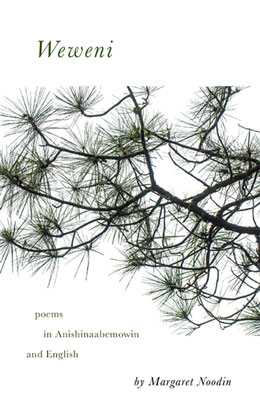A Review of Weweni
Rajiv Mohabir
Weweni
by Margaret Noodin
Detroit, MI: Wayne State University Press, 2015.
98 pages. $15.99 (paperback)

When you hold this book in your hands it will whisper to you. Noodin’s lines and spaces between lines rustle as willow switches. What draws is Weweni’s insistence, its continuation of Anishinaabemowin poetics. Noodin centers the language of The People of the Three Fires: the Odawa, Potawatomi, and Ojibwe, before she ventures into English to provide an intact Anishinaabemowin poetic. She wants “Anishnabe language to fully define the poems, rather than serve as a semiotic accent to predominantly English writing” (Noodin xi).1
I too come from a community where oral poetry has defined our bones, given us speech, and taught us how to walk; and have struggled with how exactly to write in Caribbean Hindi, offering translations that hold up in English. Noodin provides a template of how to engage the American poetic landscape conceiving a “project” of language, and writing poems that serve her concentric communities, poems that are artful and profoundly moving, poems that teach survival. Her strategy maintains the music of Anishinaabemowin and treats her own English “translations” as “lyric explanations” (ix), a notion that decenters English-only American sentiments.
By wielding Anishinabemowin, Noodin bends language as branches and forms a tent of words whose image and silences devastate. She begins her book with an invocation. In her poem “Listening” she invites us to hear the wind, not as we do, but as she does and to experience these poems using more than just our ears. Noodin writes,
I hear the wind sometimes
when the pines say “ziiziigwaa.” (3)
In this instance we hear the wind in Anishinaabemowin, a moment that both jilts us out of phonic expectations and opens book’s pages to another music. This defamiliarization is essential: in order to understand a different poetic, Weltanschauung, we must first be unsettled. But this “unsettled” feeling for Noodin is attunement — a fine tuning of the hearing apparatus that allows nuance to shape what we see. As the opening couplet resignifies the aim of this book, the reader is initiated into the sonic structures of these compositions — these “dream-songs.”
Whether the breath of the spoken poem or the wind as personified shaper of environment, we know that there is a depth to listening that does not always occur in human speech. In the case of “Listening” the whispers occur between lines, not coming from the tongue’s tip nor alveolar ridge, but rather from a deeper space of poetry. We must listen outside of ourselves. We must listen despite our expectations. The secret is that we already know how to listen.
Noodin continues in “Listening,”
The old ones tell us, “live as you are named.”
We sense the truth in our bones
if we listen. (3)
The practice of reading links the reader to the realm of the ancestors, a deeply rooted biological truth. These “old ones” know our names and know that we know how to live with integrity — they are the “truth in our bones.” There is a promise that Noodin makes at the outset of the book: if we read attentively and listen with our bones, we as readers, will glean a deeper “truth” in these dreams, these spare and profound poems. She asks us to be led by our memories and intuition through her images.
Noodin promises astonishment, a sudden anagnorisis of interconnection if we follow her images. In the poem “The Way We Meet” that,
Long ago, in the mixing
we were shaken
in every direction
different children
of the sky and the land. (63)
Peace comes when we meet one another with this recognition. Indeed this connection is not explicit, rather it’s a gentle wind throughout this collection that insists. It even crosses the North American continent and blows like trade winds across the Pacific as well. In “Aloha – Aaniin” Noodin compares words of greeting both in Hawaiian and Anishinaabemowin, positing their differences in nuance. It depends how open we are to sensing connections. Noodin writes,
Between the land and the sea
there is nothing
or there is everything. (73)
Here a conversation begins. Indeed, Noodin references the often-appropriated term “aloha” to show that an entire universe spins in its nuanced meaning. Positing a parallel to her project, with the word “Aloha” and its Anishinaabemowin connection, Noodin nods at the Hawaiian Cultural Renaissance, thriving since the 1970s, and the resurgence of ‘Ōlelo Hawai‘i. The Anishinabemowin word “Aaniin” sounds close to the Hawaiian word “‘āina,” which means “land.” Together the words “aloha ‘āina” mean a politics of connection to and loving maintenance of the land. It’s the indigenous politic that drives ecological sustainability and continued Hawaiian resistance against American occupation. Hawaiian organizing connects with indigenous struggles worldwide as a possible template for one of the ways of listening — this Noodin asserts not only through poems like “Aloha – Aaniin” but also throughout the collection.
